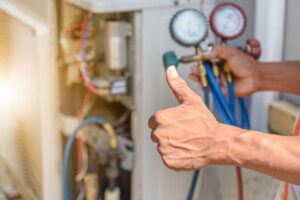
Whether it is the sweltering heat of summer or the bone-chilling cold of winter, having a functional HVAC system in your St. Louis home is crucial for comfort. While most HVAC issues require the expertise of a professional, there are a few basic DIY HVAC repairs and maintenance tasks that you, as a homeowner, can handle yourself. Not only can these DIY solutions extend the life of your HVAC system, but they can also save you money and boost efficiency. Let’s dive into some handy DIY HVAC repairs and maintenance tips.
To learn more or schedule professional HVAC maintenance with our HVAC experts, contact Galmiche & Sons today.
Basic DIY HVAC Repairs St. Louis Homeowners Can Do
While major HVAC repairs should be left to the professionals, there are several straightforward HVAC tasks that you can manage without professional help. These simple DIY HVAC repairs can keep your system running smoothly.
Here are some repairs you can tackle on your own:
- Thermostat Issues: A faulty thermostat can sometimes be the root of your HVAC woes. Check to ensure it’s set to "cool" or "heat," depending on the season. You might need to change the batteries or recalibrate the settings to maintain an accurate temperature reading. Learn more about configuring the best efficient thermostat settings.
- Condenser Coils: Regularly inspect the condition of outdoor condenser coils. Using a gentle garden hose spray, remove debris, such as leaves or grass clippings, to keep them clean and efficient. Learn more about cleaning AC coils.
- Furnace Flame Sensor: If you have a gas furnace, a dirty flame sensor may cause it to malfunction. Clean the sensor with a soft cloth to remove any dirt or buildup. Learn more about flame sensor
How to Replace HVAC Filters
Replacing HVAC filtersis one of the simplest ways to maintain your system and improve air quality, and it is another key DIY HVAC repair and maintenance task all homeowners should follow. Here are the steps:
- Locate the Filter: Find your HVAC unit’s filter slot. It could be in a return air duct, a ceiling grille, or HVAC equipment.
- Remove the Old Filter: Turn off your system before removing the old filter. Carefully slide it out, observing the direction of the airflow arrows.
- Insert the New Filter: Fit the new filter in place, matching the airflow direction. Ensure it’s snug, but do not force it if it doesn’t fit easily.
- Schedule Regular Changes: Replace filters every 30-90 days for optimal air quality and system efficiency, depending on your system and filter type.

Learn more about HVAC filters:
- 4 Reasons to Change Your HVAC Filters More Often
- Understanding Your HVAC Air Filters: A Detailed Guide
- The Importance of Air Filters in AC Performance & Efficiency
Steps for Cleaning Your Air Vents and HVAC System
Keeping air vents and the system clean can prevent blockages and improve performance. Follow these steps:
- Switch Off the System: Safety first. Always turn off the HVAC system before starting.
- Remove and Clean Vents: Unscrew vents and wash them with soapy water, then rinse and dry thoroughly.
- Vacuum Dust and Debris: Use a vacuum cleaner with a brush attachment to remove dust from vent openings and ducts.
- Clean Around the Unit: Don’t forget to tidy the area around your HVAC unit to avoid blockages.
Learn more about cleaning air vents.
DIY HVAC Repairs for Common HVAC Problems
For those occasional hiccups that can disrupt your HVAC system, a bit of troubleshooting can work wonders:
- AC Not Cooling: Check for clogged filters or a tripped circuit breaker. Sometimes, reducing the thermostat by a few degrees helps.
- Furnace Not Heating: Ensure your pilot light is on and there are no gas flow issues. Investigating the thermostat setting might also provide a quick fix.
- Uneven Temperature: Check that all your vents are open and unblocked to ensure even airflow.
Want to keep your system running smoothly and efficiently? Learn more about common DIY AC maintenance tips you can follow.
Safety Tips for DIY HVAC Repairs
While DIY projects can be rewarding, safety should always come first. Consider these tips when performing any DIY HVAC repairs or maintenance:
- Power Down: Always turn off your power at the breaker before starting any work on your HVAC system.
- Use the Right Tools: Insulated tools can prevent injury when working with electrics.
- Follow Manufacturer Instructions: Consult the owner’s manual for specific maintenance instructions when in doubt.
Learn about the two AC repairs you should never try to do
Contact Galmiche & Sons for Professional HVAC Repairs
While DIY HVAC repairs can go a long way, some problems require professional intervention. If you’re dealing with more complex issues beyond these basic repairs, it’s best to call the experts. Galmiche & Sons are seasoned professionals in HVAC repair in St. Louis. We ensure your system receives the care it needs, keeping it efficient and reliable for years.









